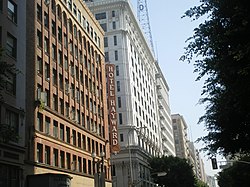Spring Street, Los Angeles
|
Spring Street Financial District
|
|

Spring Street looking north from Hotel Hayward
|
|
| Location | 354–704 S. Spring St., Los Angeles, California |
|---|---|
| Coordinates | 34°2′48″N 118°14′59″W / 34.04667°N 118.24972°WCoordinates: 34°2′48″N 118°14′59″W / 34.04667°N 118.24972°W |
| Built | 1902 |
| Architect | Morgan, Walls & Morgan; Parkinson, John |
| Architectural style | Chicago, Classical Revival, Moderne |
| NRHP reference # | 79000489 |
| Added to NRHP | August 10, 1979 |
The Spring Street Financial District, referred to as the Wall Street of the West, is a historic district in Downtown Los Angeles. The historic district includes 23 financial structures, including the city's first skyscraper, and three hotels all located along a stretch of South Spring Street from just north of Fourth Street to just south of Seventh Streets. In the first half of the 20th Century, this stretch of Spring Street was the financial center of Los Angeles, with the important banks and financial institutions being concentrated there. At least ten of the buildings in the district were designed in whole or in part by John Parkinson, who designed many of the city's landmark buildings in the early 20th Century, including the Los Angeles Memorial Coliseum, Los Angeles City Hall, Bullocks Wilshire, and Union Station. Ten of the buildings in the district have been designated as Historic-Cultural Monuments by the Los Angeles Cultural Heritage Commission.
In the 1890s, the city's business center was further north near South Spring and Temple Streets. The street can claim credit as the birthplace of the motion picture business in Los Angeles. In 1898, Thomas Edison filmed a 60-second film titled "South Spring Street Los Angeles California", mounting a giant camera on a wagon to film the bustling action along South Spring Street.
In the early 1900s, the city center began spreading south, and the city's banks and financial institutions began concentrating along South Spring Street. The first two important buildings to make the move south were the Hellman and Continental Buildings, with the Continental Building being considered the city's first skyscraper. In 1911, the Los Angeles Times boasted about the building boom on Spring Street:
The visitor to this city can at this moment observe skyscrapers in all stages of construction. It is a study which will provide the most comprehensible kind of answer to the query as to why Los Angeles is leading San Francisco, Portland, Seattle, St. Louis, Pittsburgh, Cleveland, Cincinnati, Baltimore, Detroit, Minneapolis, New Orleans, Boston, Buffalo and all other cities of anything near her in building activity as revealed by the monthly expenditures for construction work.
...
Wikipedia

